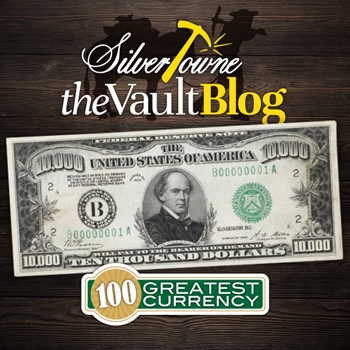
When trying to reconcile a denomination bigger than $100 in your mind, it almost seems egregious and fictitious. However, when it comes to paper money, many collectors know that it certainly isn’t even though it would be easy to assume such a thing as farce. In our continued look into Whitman Publishing’s 100 Greatest American Currency Notes series, we examine a high denomination currency note with help from authors Q. David Bowers and David M. Sundman.
#66 – Series of 1928, Small Size $10,000 Federal Reserve Note
Regardless of its small size, the $10,000 bill featuring the Secretary of the Treasury from 1861-1864 packs quite the numismatic punch. Salmon P. Chase was Treasury Secretary during President Abraham Lincoln’s administration. After resigning from the Treasury, Chase was appointed Chief Justice of the Supreme Court. He was responsible for arranging the series of currency notes issues in 1861 that would help raise money for the Civil War. His image can be found on several different types of currency albeit the $10,000 note is the highest.
Because of their high denomination and coming from a strictly numismatic perspective, some might presume that the $10,000 note would be of little interest to the public. However, it turned out to be the opposite. Those that can afford these notes will be happy to know that they are readily available. The series of 1928 and 1934 notes have the imprints of the Federal Reserve Banks on them. Series 1928 bills were issued by all branches except for Philadelphia while the 1934 bills were issued by all except Minneapolis. Small size $10,000 notes have not been printed since the 1940s.
In 1960, historic market value for a Series 1928 or 1934 $10,000 note in a Choice Crisp Uncirculated condition was $11,000. By this publication (2006), it was at $140,000.







